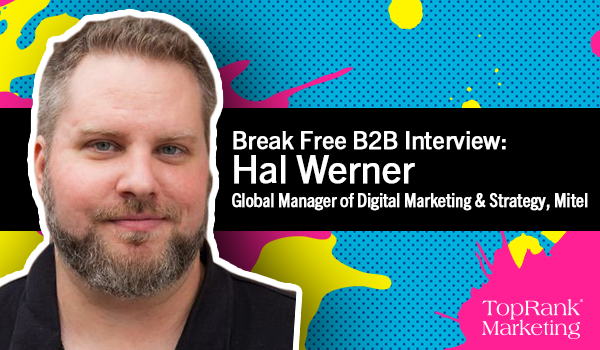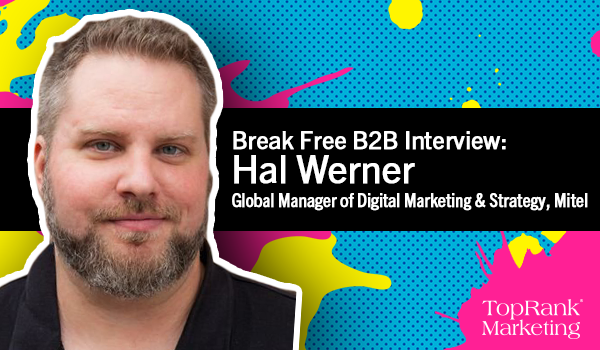
Part art, part science, all business.
This is the credo under which Hal Werner operates. As Global Manager of Digital Marketing & Strategy for Mitel, he’s responsible for overseeing the telecommunication company’s marketing programs from a holistic view, and understanding how all the pieces fit together.
Coming from a background in copywriting and content strategy, while also possessing considerable experience with SEO, PPC, and analytics tools, Hal believes the key to unlocking success in this modern era of digital marketing resides at the intersection of creativity and data.
“You find that companies are really good at one or the other,” he explains of the art and science of marketing. “And that gives you good, but when I see great, it’s almost always when the two are together. So you have a really good insight that’s maybe based on data, you have a data-led execution, and you have a creative execution of that idea. That really makes it shine because without either those parts it, can fall flat.”
You find companies that are really good at the art or science of marketing. That gives you good, but when I see great, it’s almost always when the two are together. @halwerner #MarketingStrategy #BreakFreeB2B Click To TweetIn our wide-ranging interview with him for the Break Free B2B series, Hal shared his thoughts on sophisticating attribution, merging content strategy with SEO, and creating operational structure to get the most out of your people, roles, and positions.
Break Free B2B Marketing Interview with Hal Werner
For a sampling of what’s inside, you can check out a few highlights from our chat below.
Nick: One thing we talk about here at TopRank is purpose — whether that’s your company having a purpose beyond its business function, or even down to the granular level of every piece of content you create. It’s very easy to get caught in this pattern of just churning things out. So it’s really good to take a step back, right? And just review and say, well, what is what is the purpose of this single thing we’re creating?
Hal: Yeah. If you want to create a piece of content about a topic, but you can’t create the best one, why are you creating it? Someone’s already covered that. I think it’s the same way with function in a company, right? If you don’t truly believe that you can outdo your competitors in the space for that function, then what are you wasting your time on?
If you want to create a piece of content about a topic, but you can't create the best one, why are you creating it? Someone's already covered that. @halwerner #ContentStrategy #B2Bmarketing #BreakFreeB2B Click To TweetNick: Given your background in search engine marketing, I’m really curious to get your thoughts on the intersection between content strategy and SEO. I really see them becoming sort of the same thing. Are you seeing that trend play out?
Hal: I think the most successful companies are doing that and the tough thing is, it’s hard to operationalize. It’s easy if you have a person who understands all of those things and how they work together, and they can either do it or direct it — then you’re in a good position. But if you just have a team of disparate people, it gets much harder. So I always like to start every project with an insight. If there’s not a core insight at the beginning of a project, then I tend to not actually pursue it because I think it’s kind of empty.
I think those insights can come from a lot of places, and they have to funnel into content and SEO. Sometimes the insight might be a keyword, you might see something on Google Trends blowing up that you can get on top of, or it might come from the sales team, right? The boots on the ground, ‘Hey, guys, we’re always hearing people asking about this.’ And you can feed it in that way. You might find out one topic, go plug it into a tool and find out there’s a lot of other questions people are asking to really enrich what you’re going to create.
Nick: Tactically speaking, what do you see as some opportunities to push back against the trend of diminishing organic reach and really firm up your brand?
Hal: I think there’s a couple things you can do. For one, we might actually see a little bit of reinvestment into some of the traditional branding channels and advertising channels to do that. I also think there may be some shift from a lot of digital channels that have a strong demand generation or e-commerce focus. I think a lot of those channels you might see more usage for branding. Display is an area where some industries are already doing that. Other industries may follow a little more. But I also think one of the interesting things, one of the things you guys do, is influencer marketing.
If your channels aren’t getting that reach, then these people in these other channels might be able to help your brand get out there, right? So whether whether you earn it or whether it’s paid for, you’re going to need more voices putting out there what you’re about so that not only people see you, but you begin to be associated with that thing at a critical mass.
Stay tuned to the TopRank Marketing Blog and subscribe to our YouTube channel for more Break Free B2B interviews. Here are a few interviews to whet your appetite:
- Break Free B2B Series: Clare Carr on Using Data to Drive Content Marketing Success
- Break Free B2B Series: Brody Dorland on Creating Long-Lasting Content Marketing Strategy
- Break Free B2B Series: Amisha Gandhi on Global B2B Influencer Marketing
- Break Free B2B Series: Amanda Todorovich on Creating Content that Pays Off




